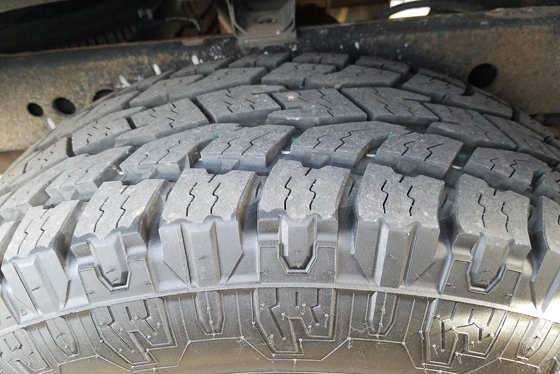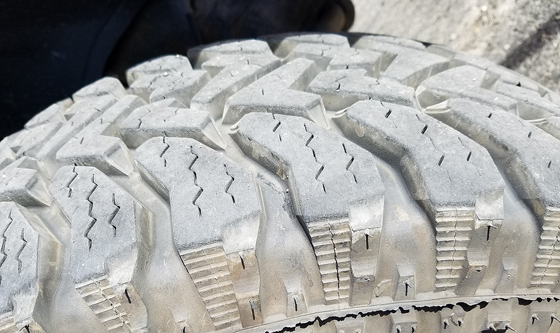How To Pick The Right Tires For Your Truck
Different tires can yield completely different outcomes in terms of truck characteristics, performance, and limitations. The variety of truck tires available means that there’s definitely a set out there that fits your priorities and the way you use your truck or SUV – it’s just a matter of finding ‘em.
All-season (on-road performance focus)
While there are exceptions to the rule, the vast majority of original equipment (OE) truck tires are all-season tires, which focus on on-road performance. If your truck was equipped with all-season tires from the factory, then you probably have plenty of miles to reflect on. From a performance standpoint, have you been satisfied with the experience? Or did the tires fall short off-road, through wintertime, or in any of your other driving contexts? Were they a hauling or towing limitation?
All-terrain (balanced on/off-road performance focus)
All-terrain truck tires are for people who use their truck to work and/or adventure. All-terrain tires are ideal for drivers who split their time on- and off-road, or in other driving contexts where extra durability and higher performance limitations are advantageous.
Mud-terrain (off-road performance focus)
For maximum off-road performance and the most aggressive look, mud-terrain tires are the way to go. Though they’re sometimes used on-road by everyday drivers, mud-terrain tires are engineered to accumulate the majority of miles in challenging off-road environments. Therefore, the ideal mud-terrain tire user spends up to 80% of the time off-road, and about 20% on-road.
The on-road drawbacks of all-terrain tires detailed above are typically amplified with mud-terrains. See All-terrain tires vs mud-terrain tires for an in-depth analysis. However, recent progress with noise-canceling tread pattern technologies has made mud-terrain tires more livable on an everyday basis than ever before. The comfort advancements have given rise to “hybrid” tires like the Nitto Ridge Grappler and Toyo Open Country R/T, which combine the best of all-terrain and mud-terrain tire technology.

Choosing the Right Tire
Having the right tire on your pickup can improve performance and be one of the best safety strategies you can employ; having the wrong tire on a pickup truck can ruin a good day. Not to overstate it, but tires are one of the most important components on your vehicle, and knowing a few basics will ease the tire selection process. Choosing the right tire can be a daunting task as there are so many options and pieces of information to keep in mind
Tire Markings
All tires are marked with the width, sidewall height ratio or overall height, rim size and load range. An example of what you might see on the sidewall is LT315/70R17 121/118O
Load Ratings
Tires get several load ratings; here’s what those letters on the tires mean:
P stands for passenger in a P-metric tire. These tires are great for lighter loads and highway use. Generally, they weigh less and cost less than a light truck tire and provide the vehicle with a smoother ride and better gas mileage. The downsides are that P-rated tires can’t handle as much of a load as LT tires and they are more easily punctured.
LT stands for light truck tires. Terminology is a little confusing in the truck market because many manufacturers label their pickup trucks as heavy duty. Class 3 trucks such as the Ford F-350, GMC 3500 and Ram 3500, and smaller, are all considered light trucks. Medium duty refers to Class 4, 5 and 6 trucks such as the Ram 5500 or Ford F-650. That leaves heavy duty for the 18 wheelers and big rigs. That means LT tires are made for HD pickup trucks.
Tire Tread Types
HT (highway terrain): HT tires are designed primarily for paved roads. They have shallow tread depths and very little or no shoulder and sidewall blocking. HT tires are typically fuel efficient and quiet. Since they don’t need to offer high traction for off-road use, they can be made with harder compounds, decreasing rolling resistance, to last a long time. These are usually the most cost-effective tires because they have a lower purchase price, get better gas mileage and last longer than any other truck tire type.
AT (all terrain): AT tires are just what their name implies, tires designed to be good in as many conditions as possible. AT tires have deeper tread depths and significant shoulder and sidewall blocking. The tread has larger spaces or voids than an HT to allow mud and snow to clear out of the tire. If the vehicle spends time driving on logging and forest service roads, then an AT tire would be a good option. AT tires are a little louder than HT tires. They weigh a little more and get a little worse gas mileage as well. AT tires cost more than HT tires, but provide better all-around performance in bad weather and on dirt or gravel roads.

Tire Buying Tips
Perhaps the biggest mistake a consumer can make when replacing tires is not using the correct size. On the sidewall of your tire, you’ll find a code that tells the tire’s size and capabilities
Here’s a sample code:
P195/60R16 63H M+S
P – Type of tire
195 – Width of the tire across the tread in millimeters
60 – Aspect ratio of the sidewall compared to the width
R – Radial construction
16 – Diameter of the rim in inches
63 – Tire’s load rating
H – Tire’s speed rating
M+S – Tire is suitable for all-season driving
If the tire-size code starts with LT instead of P, it means the tire is a light-truck tire. Light-truck tires are designed to have higher-load carrying capacities and are usually found on pickups and SUVs. These vehicles are not required to have LT tires, and in many cases, the original-equipment specification calls for passenger-car tires.
The speed rating translates into the tire’s ability to dissipate heat, or prevent heat build-up. Heat is a tire’s enemy. The more heat, the faster the tire wears, and the faster a tire might break down. A tire with a higher speed rating can dissipate more heat on long highway trips. If a consumer were to spend little time on the highway, the speed rating might not be an important factor in choosing a replacement tire.
Tires are speed rated from 99 to 186 miles per hour (159.3 to 299.3 kilometers per hour). The most common speed ratings are T (118 miles per hour or 189.9 kilometers per hour) and H (130 miles per hour or 209.2 kilometers per hour). Both of those ratings clearly exceed the nationally posted speed limits and would make excellent long-distance highway tires. If a consumer were to drive only in urban situations at low speeds, a tire with an S (112 miles per hour or 180.2 kilometers per hour) speed rating might be completely acceptable.

How to Choose the Right Truck Tire
Choosing the right tires for your vehicle is an important decision. When you drive a light truck, SUV, or crossover, the tires you choose can have a direct impact on traction, comfort, road noise, tread life, and durability. Here’s a quick guide to help you decide what truck tires are the right fit for your on- and off-road needs.
H/T (Highway Terrain) Tires for Daily Commute and Highway Driving
Chances are your SUV, crossover, or light truck came standard with a set of H/T tires built for highway driving. If you don’t plan on going off-road, and want a tire that’s great for dry and wet road conditions, then an H/T tire is probably a good option
A/T (All-Terrain) Tires for On- and Off-Road Performance
Drivers who regularly find themselves taking dirt and gravel roads in between long stretches of highway driving, should look at A/T tires. This includes folks who like to take the road less traveled on their way to a great camping spot or other outdoor activity
M/T (Mud Terrain) Tires for Off-road Enthusiasts
You know who you are. You drive a rig that is either lifted or already offers plenty of clearance for your favorite pastime: driving in extreme off-road conditions, including mud, dirt, gravel, and rock. Or maybe you just like the way a set of rugged, aggressive tires looks on your vehicle, even if they never leave the blacktop. Either way, M/T tires are for you.

Choosing the Right Truck Tires
If you are looking for a way to increase the performance and economy of your vehicle, then perhaps the best way is to buy new truck tires. However, selecting the right truck tires can sometimes get difficult, as there are a huge variety of options available and budget can be an issue.
MANUFACTURER’S RATINGS
Take a look at the manufacturer’s ratings, before actually buying new truck tires. This is because the ratings of these tires are made to suit the performance of your vehicle. The ratings are usually shown in metric on the side of your original truck tire. You can see all the information regarding the size and width of the tires suitable for your truck.
DRIVING CONDITIONS
Similar to buying new tires for ordinary cars, the driving conditions of your truck hold great importance when buying new tires. It is recommended to buy all-weather year-round tires for trucks, as they last for years. However, if you usually drive off-road or in wet weather conditions, the best option is to go for off-road truck tires
TRUCK TIRES SPEED RATINGS
When it comes to buying truck tires, it is necessary to take a look at the speed ratings. If you usually drive at speeds of 150mph, the best option is to go for “V” category truck tires. But since there are few chances of you to driving at speeds so high, it is best to go for tires which offer a speed rating of up to 130mph. These tires are cheaper as compared to the truck tires which have higher speed ratings
So, now that you are familiar with the tips mentioned above, choosing the right tires for your truck won’t be a problem at all.